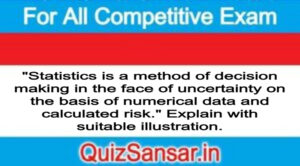
“Statistics is a method of decision making in the face of uncertainty on the basis of numerical data and calculated risk.” Explain with suitable illustration.
“Statistics is a method of decision making in the face of uncertainty on the basis of numerical data and calculated risk.” Explain with suitable illustration.
Or
What do you understand by ‘statistics’? State its characteristics.
Or
Explain critically a few of the definitions of statistics and state the one which you think to be best.
Ans.
Meaning and Definitions of Statistics
The term statistics is used in two senses :
(1) in plural, and (2) in singular. In plural sense, statistics means statistical data which are numerical facts related to the filed of an enquiry, for example population data, national income data, price level data, crime data etc. In singular sense, statistics is a science under which statistical methods regarding collection, classification, analysis and interpretation etc. are studied.
Kendall and Buckland have discussed the word statistics as follows:
Statistics (Plural) Numerical data relating to an aggregate of individuals.
Statistics (singular) – The science of collecting, analysing and interpreting such data.
I. In plural Sense
Definitions of statistical facts or statistical data
To the layman, the term statistics usually carries only the nebulous and too often, distasteful connotation of figures, and he usually understands statistics as the numbers which counts articles. This is a wrong notion. In fact, statistical data are such numbers which possess certain attributes which are the basis of statistical science.
According to Webster, “Statistics are classified facts respecting conditions of the people in a state…especially those facts which can be stated in numbers or in tables of numbers or in any tabular or classified arrangement”. This definition restricts the domain of statistics to the affairs of state. It is a very narrow definition which is not adequate for modern times.’ Its scope is not adequate for modern times. Which is very wide now a days. Secondly, it has not narrated the main characteristics of data. Thirdly, it has unnecessarily given more importance to classification and tabulation. As such, this definition is limited and inadequate.
II. In the Singular Sense
Definitions in the nature of Science of Statistics or Statistical
Methods: Statistics in singular sense has been defined as a science, the study of tools for collection, analysis and interpretation of data. Science of statistics has been defined by many authors and writers differently which may be catagorised in two parts as under :
(a) Ancient thinkers (narrow) definitions.
(b) Modern thinkers (wide) definitions.
Ancient thinkers (narrow) definitions : The definitions given by ancient and reputed thinkers and writers of old times are relatively incomplete and inadequate which do not include all the functions of statistics. Some of these definitions are examined as below :
Dr. Bowley has given definitions which are as follows:
(1) “Statistics is the science of social organism, regarded as a whole in all its manifestations”. This definition is defective since it narrows down the scope of statistics to men and his social activities. Dr. Bowley has himself accepted that Statistics is not merely a branch of political economy nor it is confined to any one science. Secondly, it mentions only measurement, but estimate is quite important in the science.
(2) ‘Statistics is the science of counting’. This definition gave importance to counting method only. Although counting is one of the important methods of statistics but it is used for small numbers. In statistics great numbers are also adequately used, the counting of which is impossible, Dr. Bowley has himself told great numbers are not counted, they are estimated. For example, wheat production in India is approximately estimated, its counting or measurement is not possible. The second limitation of this definition is that it does not throw light upon other statistical methods of analysis, and interpretation etc.
Modern Definitions: Scope of statistics has been kept wide enough in modern definitions which describe many vital methods. Some principal definitions are as follows:
According to Karmel, “The subject statistics is concerned with collection presentation, description and analysis of data which are measurable in numerical terms.”
In the words of Seligman, “Statistics is the science which deals with the methods of collecting, classifying, presenting, comparing and interpreting numerical data collected to throw somelight on any sphere of inquiry.”
Croxton and Cowden Write, “Statistics may be defined as the collection presentation, analysis and interpretation of numerical data.”
In the words of Ya-lun Chou, “It (statistics) is the science of dealing with numerical data; it encompasses all the necessary operations from the initial planning and assembling of data to the final presentation of conclusions. More specifically, it involves collecting statistical data, classifying them, analyzing and interpreting them, and drawing from them whatever conclusions are valid.”
The above definitions have included almost all important methods but these do not express the nature of subject.
The New Sense: Now-a-days, statistics is treated as a science of taking suitable decisions under the state of uncertainties.
According to Wallis and Robert, “Statistics is a body of methods for making wise decisions in the face of uncertainty.”
Characteristics of Statistics
The following are the characteristics of statistics or of data:
(1) Aggregates of facts: The facts related to an isolated item cannot be termed as statistics because no conclusion can be drawn from it, but figures of many facts are statistics because they are comparable and reasonable conclusions can be drawn. For example, the data relating to the age of a student or an accident cannot be called data, while the data regarding ages of several students or figures of several accidents are called data. Thus, not a datum, but the data are the subject matter of statistics.
(2) Affected by multiplicity of causes: Numerical figures are affected by multiplicity of causes. For example, the data of agricultural production are affected by many factors, namely climate, rainfall, irrigation, productivity of land, fertilizers and methods of farming etc. Statistical analysis of data is necessary because of their being affected by multiplicity of causes.
(3) Numerically expressed: Facts can either be expressed in qualitative terms such as, young, old, middle aged, poor etc. or in quantitative terms such as age in years, income in rupees, height in cms etc. The figures expressed in quantitative terms are statistics.
(4) Enumeration or estimation: The numerical data relating to a particular enquiry may be collected either by complete enumeration or by estimation. If the area of enquiry is limited, the enumeration and if it is wide, best possible estimation will be the basis for collection.
(5) Reasonable standards of accuracy: In collection of data reasonable degree of accuracy is very important. The reasonable degree of accuracy desired largely depends upon the nature and object of enquiry. For example, in measuring height of students even centimeters are material whereas in measuring distance from Meerut to Jaipur accuracy upto kms. is enough, metres can be ignored. Contrary to this, in measuring distance from earth to sun or to any other satatile, thousands of kms. can be ignored. Thus standard of accuracy may be different in different circumstances.
(6) Systematic collection : Before collecting data, a suitable plan for collection to be prepared and then the work be carried out in a systematic manner. Horace Secrist has rightly said that Data collected in a haphazard manner which are not related to the purpose of enquiry would give fallacious and misleading conclusions. For example, the data related to monthly budget expenditure of some families, collected without any plan and in unsystematic manner, cannot be called statistics. But if the data related to family budget of the workers are collected according to plan and in a systematic manner, the same will be called data because suitable conclusions can be drawn from them.
(7) Predetermined purpose: The scope and purpose of enquiry should be stated clearly before actually conducting the enquiry. The definition of various terms unit of collection and measurement also help in ensuring that the data are relevent to the purpose in hand. For example, if data are being collected regarding the wages of workers of an industry, the object of such collection be determined before has to estimate for standard of living or to consider the demand for increased wages for comparable analysis.
(8) Placed in relation to each other: The main object of collection of facts and figures is to facilitate a relative study. In other words, statistics should be capable of comparison. Non-comparable facts are only figures. For comparison, homogeneity and uniformity of data are necessary. For example, data related to income of some persons, their ages, height of trees, the number of students in a college are not comparable facts. Hence, these cannot be called as data. For identifying as data, it is necessary that figures should be comparable as regards time, place or condition.
Thus it is clear that the absence of aforesaid characteristics of numerical data cannot be called statistics. As such, all statistics are numerical statement of facts but all numerical statement of facts are not statistics.






